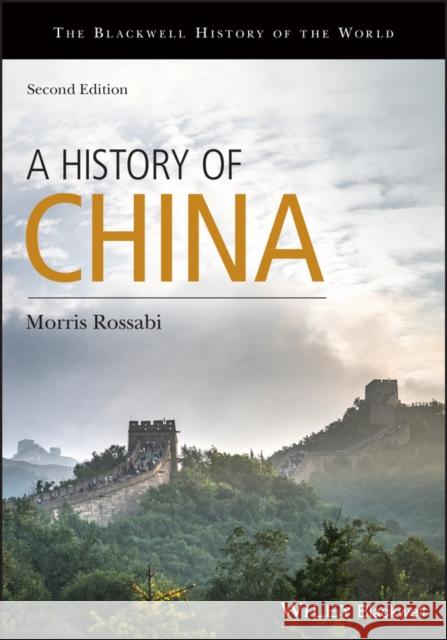A History of China » książka



A History of China
ISBN-13: 9781119604181 / Angielski / Miękka / 2021 / 432 str.
A History of China
ISBN-13: 9781119604181 / Angielski / Miękka / 2021 / 432 str.
(netto: 294,62 VAT: 5%)
Najniższa cena z 30 dni: 223,82
ok. 16-18 dni roboczych
Dostawa w 2026 r.
Darmowa dostawa!
Series Editor's Preface xPreface xiiiAcknowledgments xviiList of Illustrations xixList of Maps xxiiA Note on Romanization xxiiiPart I China Among "Barbarians" 11 Early History, to 1027 BCE 3Land and Settlement 3Early Mankind 5Agricultural Revolution in the Neolithic Era 6Xia: The First Dynasty? 11The Shang and the Origins of Chinese Civilization 15Oracle Bones 17Ritual Objects as Historical Sources 18Shang Society 20Note 23Further Reading 232 Classical China, 1027-256 BCE 24"Feudalism"? 24Changes in Social Structure 29Political Instability in the Eastern Zhou 30Transformations in the Economy 33Hundred Schools of Thought 35Daoism 36Popular Religions 39Confucianism 40Mohism 46Legalism 48Book of Odes and Book of Documents 51Secularization of Arts 53Note 55Further Reading 553 The First Chinese Empires, 221 BCE-220 CE 56Development of the Qin State 58Qin Achievements 60Failures of the Qin 63Han and New Institutions 66Han Foreign Relations 70Emperor Wu's Domestic Policies and Their Ramifications 75Wang Mang: Reformer or Usurper? 77Restoration of a Weaker Han Dynasty 78Spiritual and Philosophical Developments in the Han 81Han Literature and Art 85Further Reading 924 Chaos and Religious and Political Responses, 220-581 93Three Kingdoms 93Rise of South China 95Foreigners and North China 97Northern Wei 100Spiritual Developments, Post-Han 104Buddhism Enters China 105Literature, Science, and the Arts in a Period of Division 111Note 115Further Reading 116Part II China Among Equals 1175 Restoration of Empire under Sui and Tang, 581-907 119Sui: First Step in Restoration 121Disastrous Foreign Campaigns 126Origins of the Tang 127Taizong: The Greatest Tang Emperor 128Tang Expansionism 131Irregular Successions and the Empress Wu 133Tang Cosmopolitanism 136Arrival of Foreign Religions 138Glorious Tang Arts 144Decline of the Tang 146Tang Faces Rebellions 150Uyghur Empire and Tang 151Tang's Continuing Decline 152Suppression of Buddhism 155Final Collapse 156Efflorescence of Tang Culture 159Notes 164Further Reading 1646 Post-Tang Society and the Glorious Song, 907-1279 165Five Dynasties and Ten Kingdoms 165Song: A Lesser Empire 169A New Song Elite 171Neo-Confucianism: A New Philosophy 173Attempts at Reform 174Women and the Song 180The Khitans and the Liao Dynasty 181Expansion of Khitan Territory 183Preservation of Khitan Identity 183Fall of the Liao 185Xia and Jin: Two Foreign Dynasties 186Song Arts 188Southern Song Economic and Cultural Sophistication and Political Instability 192Note 196Further Reading 197Part III China and The Mongol World 1997 Mongol Rule in China, 1234-1368 201Rise of Chinggis Khan 203Legacy of Chinggis Khan 205Expansion and Early Rule of Empire 205Sorghaghtani Beki, Möngke, and Khubilai 206Unification of China 208Khubilai's Policies 208Multiethnic and Multireligious China 210Khubilai and Chinese Culture 211Decline of the Yuan 216Legacy of the Mongols 218Note 220Further Reading 2218 Ming: Isolationism and Involvement in the World, 1368-1644 222A More Powerful State 225Opening to the Outside World 228A Costly Failure 233Conspicuous Consumption 233Arts in the Ming 235Neo-Confucianism: School of the Mind 239A Few Unorthodox Thinkers 242Ming Literature 242Buddhism: New Developments 246Social Development and Material Culture 247Violence in the Sixteenth Century 249Fall of the Ming Dynasty 251Further Reading 255Part IV China In Global History 2579 Early Qing: A Manchu Dynasty, 1644-1860 259Preserving Manchu Identity 262Kangxi and the Height of the Qing 263Western Arrival 264Jesuits in China 266Expansion of China 268Qing Cultural Developments 271Qing Faces Economic Problems 274Stirrings of Discontent 277The Western Challenge 278Opium Wars 280Explanations for the Decline of the Qing 285Further Reading 28610 Late Qing, 1860-1911 287Nian and Other Minor Rebellions 288Taiping Rebellion 289Other Rebellions 293Foreign Threats 296Differing Court Responses to Challenges 298Antiforeign Acts and Foreign Reactions 302Losses in Southwest China 304Japan Emerges 305Sino-Japanese Conflict 306Scramble for Concessions and US Response 308China Humiliated and the Reformers 309Boxer Movement 311Court Reforms 313Fall of the Qing 315Note 316Further Reading 31611 The Republican Period, 1911-1949 317The 1911 Revolution and Its Aftermath 319Warlords in Power 321The May Fourth Movement and Intellectuals in the Post-First World War Period 323Communist Party 326Rise of Chiang Kai-shek 330Guomindang Dominance 333Communist Party Revival 337Long March and Aftermath 339The Sino-Japanese War 341The Pacific War, the Communists, and the Guomindang 343Civil War in China 347Further Reading 34912 The Communist Era in China, 1949 Onwards 350Early Pacification of Border Areas 352Early Foreign Relations 355Recovery from Wars 357Cracks in the Communist World 360Great Leap Forward 362Return to Pragmatism 365An Isolated China 366Great Proletarian Cultural Revolution 368China Reopens Its Doors 371Dramatic Changes and Modernization 374Tiananmen Disturbance of 1989 and Its Aftermath 378The Present Status of China 385Further Reading 395Index 397
MORRIS ROSSABI, PhD, is Distinguished Professor of History at City University of New York and Adjunct Professor at Columbia University. He is the author of several celebrated works on Asian history and has collaborated on exhibitions at the Metropolitan Museum of Art and the Cleveland Museum of Art.
1997-2025 DolnySlask.com Agencja Internetowa
KrainaKsiazek.PL - Księgarnia Internetowa









